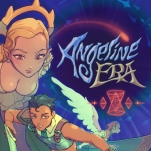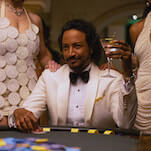Game play combines strategies common to other collectible card games with a series of mini-games. You build decks, each featuring three Bakugan and cards that provide boosts for your monsters and help set the terms of the battle.
But deck-building strategy only gets you so far. To play a Bakugan, you need to aim and throw balls onto cards, steering them to land where you want. Opponents have to do the same thing, and players have the opportunity to shoot at the balls as they move, to throw them off course. The skills can be mastered with practice, but the main result is extending every fight.
Once two creatures share a card, you compare stats and engage in a mini-game to determine which monster one-shots the other. The three randomly selected options are a music-game style match where players press buttons as they line up with notes onscreen, a shooter where you must hit specific symbols, and a contest of who can shake the controller faster. Sometimes this is a frustratingly meaningless waste of time, as the games are only capable of changing things if the margin between the stats is relatively narrow. At least the shooter and rhythm game involve some skill. The shaking game will just make your arm tired.
Since the main draw is fighting tons of battles, expect to do a lot of grinding. Money from winning matches is needed to buy or upgrade Bakugan, and you’ll often want multiple copies of the same creature with different elemental affinities that make them better against opposing decks.
In spite of the flaws, it’s clear that a lot of work went into Battle Brawlers. The show’s cast does the voice acting, and every card available in the real world is in the game. It’s likely to appeal to players who love the show, and turn anyone else off.


















![HBO teases new Euphoria, Larry David, and much more in 2026 sizzle reel [Updated]](https://img.pastemagazine.com/wp-content/avuploads/2025/12/12100344/MixCollage-12-Dec-2025-09-56-AM-9137.jpg)





















